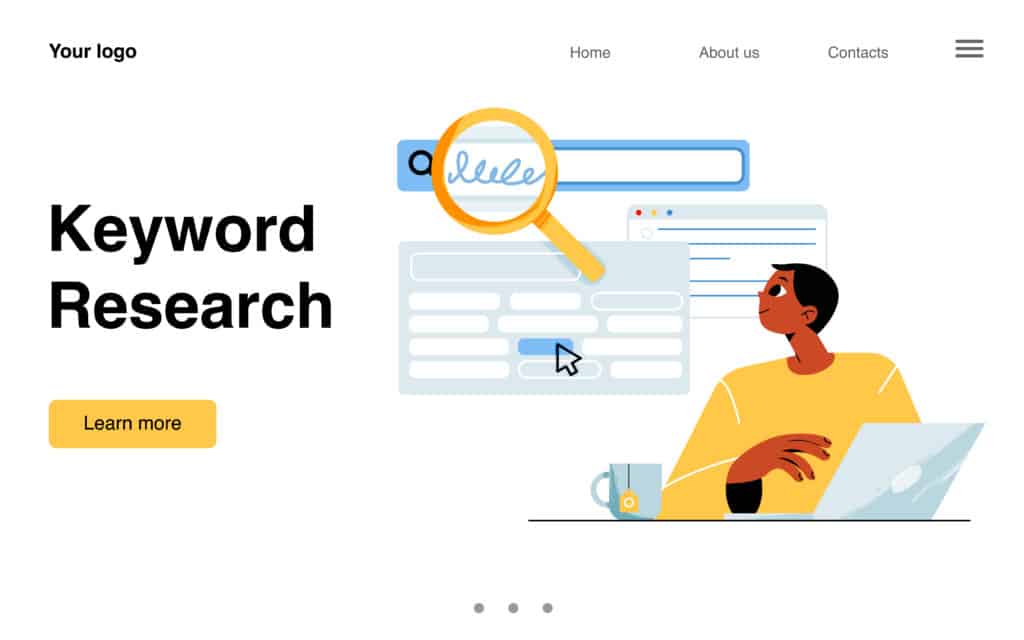Content creators use keywords to target specific search queries to rank their content higher in Google search results.
Keywords are just as important today as they were a few decades ago. And despite their importance, other essential components in optimising your content exists. It would help if you also focused on on-page technological upgrades, link building, social signals, navigation, and schema markup should all be used to supplement your content.
You probably have a few questions:
- What exactly are keywords, and why are they so important?
- What are the most effective keyword research tools? How can I do effective keyword research and optimisation?
Don’t worry; we will answer all these questions below.
What are keywords, and why are they so important?

Keywords are terms or phrases that users type into engines such as Google. People are using these keywords to find the answers to their problems. They want a relevant solution to the question they are asking the search engine.
Google currently analyses hundreds of ranking signals, of which keyword optimisation is only one. To have a successful SEO campaign, you don’t need to focus on all the ranking singles to start seeing results. It would help if you had particular keywords on your website to rank higher and get more visibility in search engine results for these phrases. Selecting the appropriate keywords is a crucial first step toward ranking on the first page of Google.
It would help if you first learned how Google works to understand why keywords are crucial. Google used to rank sites that focused entirely on a single keyword. Essentially, websites were stuffing each of their pages with their primary keyword. Google would then assume that the page discussed that keyword and what the end-user was after. Over the years, Google has wised up to many of these early techniques and now focuses on many more elements, not just rank pages with a high frequency of keywords.
Google now wants website creators to generate as much value for the end user as possible and answer the questions best. There are no set rules, so it’s essential to include your primary and other relevant (secondary) keywords and produce content that best answers the user’s query. This could be a step-by-step guide on how to do something or could be a long-form article.
Because keyword optimisation is so easy to get lost in, your main objective should be to publish relevant pieces and content that offer value and encourages people to connect with you. Doing this will automatically include keywords relevant to the topic you are writing about.
What is a Keyword?

Keywords are the phrases you want to rank for. These high-volume search phrases can provide significant traffic to your site. If we use the same example as before, your essential keywords are all terms related to buying laptops online.
As a general guideline, your core keywords should be broad in scope and dispersed throughout the material on your site. Your essential keywords should appear in the title, headers, anchor links, and first and final lines. A maximum of 2-3 significant keywords should be included on each page, with a minimum of one.
For example, if you’re helping people lose weight, you might have the following keywords:
- How to lose weight
- Help to lose weight
- Ways to reduce weight
You should include these keywords, meta titles, descriptions, and headers in your content.
Keyword Strategy:
Developing a solid keyword strategy is crucial for any successful SEO campaign. A keyword strategy involves identifying and targeting specific keywords relevant to your business, products, or services. By strategically selecting keywords that align with your target audience’s search behaviour, you can optimise your website’s content and improve its visibility in search engine results. A well-planned keyword strategy helps drive organic traffic, attract qualified leads, and ultimately increase conversions. It involves choosing high-volume keywords and considering keyword competitiveness, search intent, and relevance to your business goals.
How do to keyword research

Keyword research is the foundation of any effective SEO campaign. It involves identifying and analysing the search terms and phrases users enter into search engines. You can gain insights into popular and relevant keywords related to your industry by conducting comprehensive keyword research. This research helps you understand the language your target audience uses, the topics they are interested in, and the keywords that can drive targeted traffic to your website. You can uncover long-tail and high-value keywords through keyword research and discover new content ideas that resonate with your audience.
1. Identify your services and goods
When developing a keyword strategy, it is crucial to consider the nature of your business and the products or services you offer. By understanding your unique value proposition, you can select keywords that effectively capture the essence of what you have to offer. Let’s explore two scenarios to illustrate this point.
Selling Laptop Computers: It is essential to align your keyword strategy with this specific product if you operate a business that sells laptop computers. Your primary focus should be on keywords that are directly related to laptops. For instance, you may consider using introductory keyword phrases like “buy laptop computers,” “best laptops for sale,” or “affordable laptops online.” These keywords accurately reflect your business and the intent of users looking to purchase laptops. Additionally, you may include secondary keywords such as “laptop brands,” “laptop specifications,” or “laptop reviews” to cover related aspects that potential customers might be searching for. By targeting these relevant keywords, you increase the likelihood of attracting qualified traffic to your website and reaching potential laptop buyers.
Owning a Restaurant: In the case of owning a restaurant, your keyword selection should reflect your establishment’s unique features and offerings. Instead of focusing solely on specific products like laptops, you should consider keywords that capture the essence of the dining experience you provide. For example, you might choose primary keyword phrases like “family-friendly restaurant,” “fine dining experience,” or “cuisine for food enthusiasts.” These keywords emphasise aspects such as spending quality time with family, the professionalism of your service, and the culinary experience you offer. Additionally, incorporating secondary keywords like “best local restaurant,” “authentic cuisine,” or “chef specialties” can further enhance your keyword strategy. By aligning your keywords with your restaurant’s core values and offerings, you increase the chances of attracting diners looking for a memorable dining experience.
In both cases, the goal is to select keywords that accurately represent what you have to offer and align with the expectations and intentions of your target audience. By focusing on keywords directly related to your products, services, or unique selling points, you can improve the relevance and visibility of your website in search engine results. I’d like you to conduct thorough keyword research to find the most suitable primary and secondary keywords to attract the right audience and drive valuable traffic to your business.
2. Consider what your consumers require.

Once you have identified your clients’ issues and demands, aligning your keyword strategy with their specific needs and preferences is essential. Let’s go ahead and expand on the example of running a restaurant to show how secondary keywords can support your primary keyword and cater to your client’s requirements.
Suppose your primary keyword is “local restaurant,” indicating that your establishment is focused on providing a dining experience within a specific locality. You can incorporate secondary keywords related to their dining experience to address your clients’ various demands. Here are a few examples:
Spending Time with Family: If your restaurant caters to families and provides a family-friendly environment, you can utilise secondary keywords such as “family-friendly restaurant,” “kid-friendly dining,” or “restaurants for family outings.” These keywords highlight the importance of spending quality time with family while enjoying a meal at your establishment.
Selecting a Proposed Location: If your restaurant is known for its prime location or scenic views, you can incorporate secondary keywords such as “waterfront dining,” “restaurant with a view,” or “romantic dinner spot.” These keywords emphasise the location-based benefits of your restaurant and attract customers looking for a specific ambience or setting.
Dining Well in the Evening: If your restaurant offers a unique evening dining experience, you can use secondary keywords like “fine dining restaurant,” “gourmet cuisine for dinner,” or “elegant evening dining.” These keywords convey your restaurant’s sophistication and culinary excellence during evening hours, attracting customers seeking a memorable dining experience.
Enjoying Breakfast: If your restaurant serves breakfast or is mainly known for its morning offerings, you can incorporate secondary keywords such as “breakfast spot,” “brunch restaurant,” or “delicious morning meals.” These keywords highlight the availability of breakfast options and attract customers looking for a satisfying start to their day.
By incorporating these secondary keywords into your content and website optimisation, you can support your primary keyword, “local restaurant”, and address your target audience’s specific needs and demands. This comprehensive keyword strategy helps potential customers find your restaurant when searching for particular dining experiences, locations, or meal times. It allows you to align your content with their expectations and attract the right audience to your establishment. Remember to conduct keyword research and choose secondary keywords that best represent your restaurant’s unique selling points and offerings.
3. Check out your competitors

Examining your competition is a valuable strategy for discovering new keywords and gaining insights into their SEO practices. By utilizing spy tools like SEMRush or Ahrefs, you can uncover valuable information about the keywords your competitors use and how they perform in search engine rankings. Here’s an expanded explanation of this approach:
Research Competitors’ Keywords: Using tools like SEMRush or Ahrefs, you can analyse your competitors’ websites to identify their target keywords. These tools provide valuable data on the organic keywords for which your competitors are ranking, the associated search volume, and even the estimated traffic generated from those keywords. This research helps you understand the keywords relevant to your industry and gives you insights into your competitors’ SEO strategies.
Analyse Competitors’ Rankings: Once you have identified the keywords your competitors are targeting, you can examine how well they rank for those keywords. Look for patterns or trends in their rankings to identify which keywords are most effective in driving traffic and visibility for them. Pay attention to the keywords where they consistently outrank other competitors and try to understand the factors contributing to their success.
Learn from Competitors’ Keyword Usage: Take a closer look at how your significant competitor utilises primary and secondary keywords throughout their website. Examine their page titles, meta descriptions, headings, and content to see how they incorporate relevant keywords naturally and effectively. Note the placement and frequency of keywords to understand their on-page optimisation strategies. This analysis can give you ideas on improving your keyword usage and optimising your content for better search engine rankings.
Adapt and Refine Your Strategy: With insights from analysing your competitors’ keyword usage, you can adapt and refine your keyword strategy. Identify opportunities to target keywords your competitors might need to include or underutilise. Look for long-tail keywords or specific variations that can help you carve out a unique niche in the market. Please monitor and evaluate your keyword performance, making adjustments as needed based on your observations and results.
Remember, while analysing your competition can provide valuable insights, it’s essential to strike a balance between learning from them and maintaining your unique value proposition. Use this information to enhance your own keyword strategy and differentiate yourself in the market rather than simply replicating what your competitors are doing.
4. Research more keywords
Regarding keyword research, several tools and platforms are available to assist you. Here’s a breakdown of recommended tools and platforms for finding primary and secondary keywords:
Keyword Planner (Google Ads): Keyword Planner is a free tool provided by Google Ads. This tool is handy for identifying primary keywords with high search volumes and potential traffic. It allows you to explore keyword ideas, search volumes, and competition levels. You can enter primary keywords related to your business or industry, and Keyword Planner will provide you with additional keyword suggestions, along with their search volumes and trends.
Google Search: Performing searches on Google itself is an effective way to understand what primary keywords are commonly used by users and what type of content is currently ranking. Observe the search suggestions that appear as you type and the “People also ask” and “Related searches” sections. These can give you insights into relevant primary and secondary keywords popular among users.
Quora: Quora is a question-and-answer platform where users seek advice, share knowledge, and engage in discussions. It can be a valuable resource for finding secondary keywords by exploring the questions related to your industry or niche. Look for recurring topics and keywords Quora users use to address their concerns. These keywords can provide insights into your target audience’s specific queries and interests.
SEMRush: SEMRush is a comprehensive SEO tool that offers keyword research capabilities. It provides keyword suggestions, search volumes, competition levels, and insights into your competitors’ keyword strategies. You can explore primary and secondary keywords using SEMRush, helping you refine your keyword selection and identify gaps in your competitors’ strategies.
Ahrefs: Ahrefs is another powerful SEO tool that offers keyword research features. Ahrefs can help you discover popular primary and secondary keywords in your industry and identify opportunities to target specific keywords with less competition. It provides detailed keyword analysis, search volumes, keyword difficulty scores, and competitor analysis.
Using these tools and platforms, you can create a robust keyword research process. Start with Keyword Planner and Google Search to identify primary keywords, then use Quora, SEMRush, and Ahrefs to expand your research and uncover relevant secondary keywords. Remember to analyse search volumes, competition levels, and relevancy to select the most effective keywords for your content and SEO strategy.
5. Map the keywords to pages

To optimise your website’s SEO, it’s essential to ensure that each division and page of your site focuses on specific keywords. Here’s how you can effectively incorporate primary and secondary keywords into your website:
Primary Keywords and Page Focus: Assigning a specific primary keyword to each page helps search engines understand that page’s main topic and purpose. For example, if you have a page dedicated to laptop computers, your primary keyword could be “laptop computers for sale.” Could you make sure the content on that page revolves around this keyword, providing valuable information and addressing related subtopics? Focus on one primary keyword per page to maintain clarity and relevance.
Secondary Keywords on Each Page: While primary keywords take precedence, it’s beneficial to incorporate two or three secondary keywords on each page. Secondary keywords should be relevant to the primary topic and provide additional context to the content. For the laptop computers page, examples of secondary keywords could include “best laptops for gaming,” “affordable laptops with long battery life,” or “top-rated laptop brands.” You can integrate these secondary keywords into your content to enhance its relevance and comprehensiveness.
Utilising Secondary Keywords in Blog Articles, Case Studies, and Press Releases: To capitalise on secondary keywords further, create blog articles, case studies, or press releases that specifically target these keywords. These types of content allow you to delve deeper into subtopics related to your primary keyword. For example, you could write a blog post titled “10 Tips for Choosing the Perfect Gaming Laptop” or a case study showcasing how your laptops meet the needs of professional designers. Incorporating secondary keywords into such content increases your website’s visibility and attracts users searching for those specific topics.
Focus on creating high-quality, informative content that addresses user intent and incorporates relevant primary and secondary keywords to enhance the visibility and discoverability of your website. Remember, the key is to naturally integrate keywords into your content while providing value to your audience. Avoid keyword stuffing or over-optimizing, as this can harm your SEO efforts.
Enhancing Website Visibility and Ranking Factors
Search engines play a vital role in connecting users with the information they seek. The most prominent search engine is Google, but others like Bing and Yahoo exist. Search engines use complex algorithms to analyse websites and determine their relevance to a user’s search query. Optimising your website for search engines involves various factors, such as keyword optimisation, technical SEO, user experience, and backlink profile. By understanding how search engines work and aligning your website with their ranking factors, you can improve your website’s visibility and increase the chances of appearing on the first page of search results.
Unleashing the Power of Long Tail Keywords

Long tail keywords are longer and more specific search phrases that users enter into search engines. These keywords typically have lower search volume but are highly targeted and specific to a particular topic or niche. Long tail keywords are valuable for SEO because they often indicate strong search intent, meaning that users searching for these terms are more likely to convert into customers. By targeting long tail keywords in your content, you can attract highly relevant traffic, face less competition, and improve the chances of ranking higher in search engine results.
Navigating Keyword Search Volume
Monthly search volume refers to the average number of times a particular keyword is searched for within a given month. It provides insights into the popularity and demand for a specific keyword. High search volume keywords typically indicate a broader audience and higher competition, while low search volume keywords may have less competition but also potentially fewer users searching for them. Balancing keyword search volume with relevance and competition is crucial when developing your keyword strategy. It’s important to target keywords with a healthy search volume that aligns with your business goals and audience reach.
Optimising Content for User Relevance and Engagement

Search intent refers to the underlying purpose or motivation behind a user’s search query. Understanding search intent is crucial for optimising your website’s content to align with users’ needs. Search intent can be categorised into different types, such as informational, navigational, transactional, and commercial. By analysing search intent, you can tailor your content to provide users with the most relevant and valuable information. This improves user experience, increases engagement, and enhances the chances of ranking higher in search results. Aligning your content with the searcher’s intent helps you attract the right audience and drive more qualified traffic to your website.
